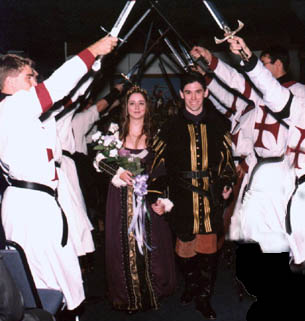
 The Maid of Honor and Bridesmaids While the Groom and his best men were fighting for the bride, she was helped by a group of women who would get her away from her family or other suitors so she could be "captured" by the man of her choice. The Maid of Honor and the Bridesmaids are honored roles today. Handfasting In the rural areas of Great Britain, priests might only visit remote villages sporadically. In order for couples to pledge their betrothal, they joined hands, his right to her right, his left to her left and wrapped them with a ribbon. Done in front of witnesses, this made them officially "married" for a year and a day, following which they could renew permanently or for another year and a day.
Diamond Engagement Rings In medieval times, the groom would most often pay for the bride's hand in marriage. Precious stones were often included in this payment as a symbol of his intent to marry. While this practice eventually stopped, the gift of the precious stone as a symbol of intent remains today. Bridal Showers This event has its roots in Holland. When a bride's father did not approve of the husband-to-be, he would not provide her with the necessary dowry. The brides friends would therefore "shower" her with gifts so she would have her dowry and thus marry the man of her choice. While dowries are long gone today, the practice of giving gifts to the bride-to-be remains. Symbolism and Superstition
Throwing the Boquet or Garter Brides were sometimes stripped at the altar by the men getting favors. Articles of clothing from a bride were considered to be lucky. It was thought that a man who gave his lady love the garter from a bride would ensure her faithfulness. Brides had be be creative as a means of self-preservation. There are paintings depicting brides with sleeves and bodice totally be-ribboned to avoid being stripped. Bride or groom would throw the garter while they got away, or have the men compete for it. This evolved into throwing the boquet. |

